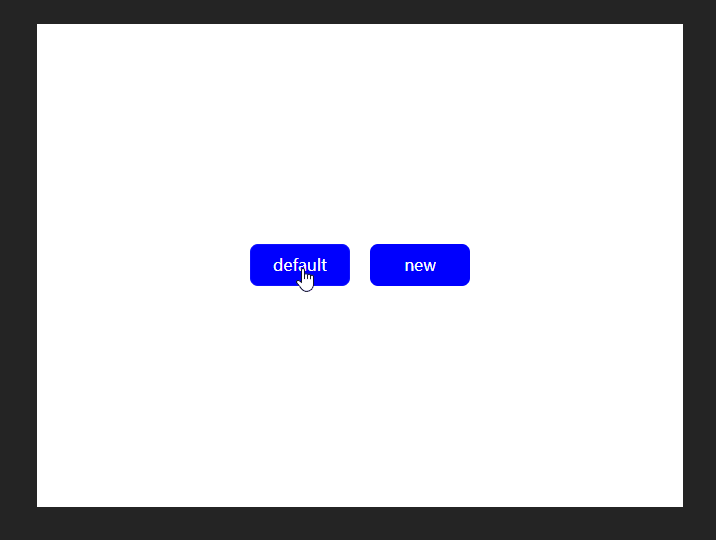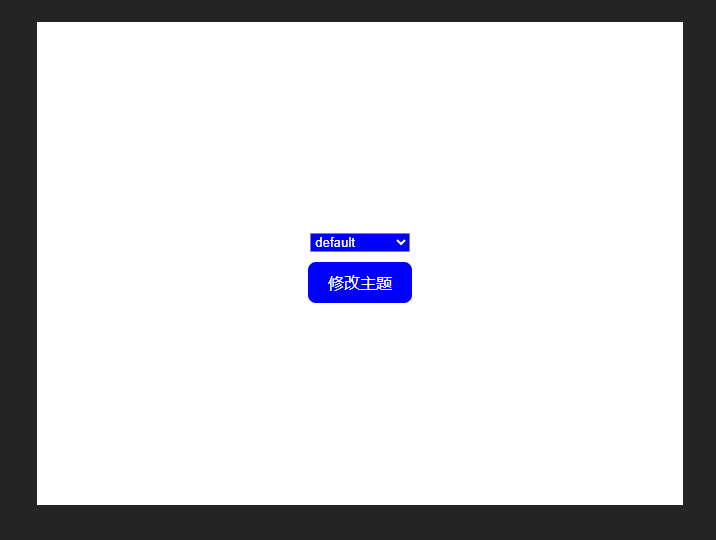在Vue 中如何使用动态样式
原创在Vue 中如何使用动态样式
原创
在日常开发中随着用户需求的日益多样化,界面设计也日益复杂,如何在保持代码简洁的同时,实现界面的动态变化,是一项不小的挑战。动态样式作为实现界面动态变化的关键技术手段,不仅能够提升用户体验,还能为开发者提供更加丰富的设计空间。
动态样式在Vue中的应用,主要体现在通过数据绑定、计算属性、条件渲染等技术,使得界面元素的样式能够根据数据状态、用户交互等条件实时调整。这不仅能够实现界面的个性化展示,还能根据不同的使用场景提供更为直观、响应式的视觉反馈。
下面将总结几种动态样式常用的方法
动态style
内联样式绑定一个对象,
\:style 是一个动态绑定样式的指令,它允许你将样式应用到元素上,并且这些样式可以根据组件的状态或者数据动态变化。
<template>
<div class="home">
<button :style="{backgroundColor: backgroundColor[theme]}" @click="changeColor('default')">default</button>
<button :style="{backgroundColor: backgroundColor[theme]}" @click="changeColor('new')">new</button>
</div>
</template>
<script setup>
import { ref, reactive } from 'vue';
let theme = ref('default')
let backgroundColor = reactive({
default: 'blue',
new: 'red',
})
function changeColor(val) {
theme.value = val
}
</script>
<style lang="scss">
.home{
background-color: #fff;
width: 80vw;
height: 50vh;
display: flex;
align-items: center;
justify-content: center;
button{
width: 100px;
margin: 10px;
}
}
</style>动态class
<template>
<div class="home">
<button :class="theme" @click="changeColor('default')">default</button>
<button :class="theme" @click="changeColor('new')">new</button>
</div>
</template>
<script setup>
import { ref, reactive } from 'vue';
let theme = ref('default')
function changeColor(val) {
theme.value = val
}
</script>
<style lang="scss">
.home{
background-color: #fff;
width: 80vw;
height: 50vh;
display: flex;
align-items: center;
justify-content: center;
button{
width: 100px;
margin: 10px;
}
.default{
background-color: blue;
}
.new{
background-color: red;
}
}
</style>动态class 动态style 效果

scss变量
SCSS变量是指在SCSS(Sass的一种语法)中定义的变量,这些变量可以在整个项目中的任何SCSS文件中使用。这样做的好处是可以在一个地方集中管理项目的样式,便于统一修改和维护。
SCSS变量的优势
- 一致性:通过全局变量,可以确保整个项目中使用的颜色、字体大小、间距等样式属性保持一致。
- 可维护性:如果需要修改某个样式属性,只需修改全局变量的值,而不需要在多个文件中逐一修改。
- 模块化:全局变量有助于将样式代码模块化,使得代码更加清晰和易于管理。
实际使用
.vue文件中 使用 scss变量
style标签中生命\$themeColor变量
<template>
<div class="home">
<button>按钮</button>
</div>
</template>
<script setup>
</script>
<style lang="scss">
$themeColor: #2779e4;
.home{
background-color: #fff;
width: 80vw;
height: 50vh;
button{
margin: 20vh auto;
color: #fff;
background-color: $themeColor;
}
}
</style>引入scss 文件使用
在实际开发中往往 会将scss变量的定义统一放在一个公共scss文件里管理,
/scr/common 下创建 index.scss文件
然后 在 style标签中引入scss文件
index.scss
$themeColor: #2779e4;.vue
<style lang="scss">
@import "@/common/index.scss";
.home{
background-color: #fff;
width: 80vw;
height: 50vh;
button{
margin: 20vh auto;
color: #fff;
background-color: $themeColor;
}
}
</style>实现全局scss变量
考虑到项目在实际开发中,各种组件都需要统一使用样式变量,每个页面引入是不现实的,最佳的解决方案就是,将scss中的变量在全局引入,所有页面都可以访问到.
安装 sass
npm install sassvite.config.ts文件中 设置css预处理器
import { defineConfig } from 'vite'
import vue from '@vitejs/plugin-vue'
import { resolve } from 'path'
const pathResolve = (dir: string): any => {
return resolve(__dirname, ".", dir)
}
const alias: Record<string, string> = {
'@': pathResolve("src")
}
// https://vitejs.dev/config/
export default defineConfig({
plugins: [vue()],
resolve: {
alias
},
css: {
// css预处理器
preprocessorOptions: {
scss: {
// 引入 index.scss 这样就可以在全局中使用 index.scss中预定义的变量了
// 给导入的路径最后加上;
additionalData: '@import "@/common/index.scss";'
}
}
}
})有了以上配置,无需再单独引用index.scss,style标签中就可以直接使用 \$themeColor变量了,
<style lang="scss">
.home{
background-color: #fff;
width: 80vw;
height: 50vh;
button{
margin: 20vh auto;
color: #fff;
background-color: $themeColor;
}
}
</style>动态修改
原理:提前设置好多种皮肤的对应的样式,然后 利用 css 自定义属性选择器和jsdom操作方法 setAttribute 动态修改 自定义属性 来匹配不同的样式
1.全局配置多种皮肤样式
index.scss
$themeColor: #2779e4;
$themes:(
default: (
backgroundColor: blue,
),
new: (
backgroundColor: red,
)
);
@mixin themeify {
@each $theme-name, $theme-map in $themes {
$theme-map: $theme-map !global;
[data-theme="#{$theme-name}"] & {
@content;
}
}
}
@function themed($key) {
@return map-get($theme-map, $key);
}
@mixin getBackgroundColor($color) {
@include themeify {
background-color: themed($color)!important;
}
}
@mixin getColor($color) {
@include themeify {
background-color: themed($color)!important;
}
}2 .vue文件中获取全局皮肤颜色设置对应样式,且提前初始化样式(这一步可以放到 App.vue中 全局出发一次)
<template>
<div class="home">
<select v-model="theme">
<option value="default">default</option>
<option value="new">new</option>
</select>
<button @click="changeTheme">修改主题</button>
</div>
</template>
<script setup>
import { ref, onBeforeMount } from 'vue';
let theme = ref('default')
function changeTheme() {
window.document.documentElement.setAttribute( "data-theme", theme.value );
}
onBeforeMount(() => {
changeTheme(theme.value)
})
</script>
<style lang="scss">
.home{
background-color: #fff;
width: 80vw;
height: 50vh;
display: flex;
flex-direction: column;
align-items: center;
justify-content: center;
select{
width: 100px;
margin: 10px;
@include getBackgroundColor("backgroundColor");
}
button{
// background-color: $themeColor;
@include getBackgroundColor("backgroundColor");
}
}
</style>效果

vue3中 scss和js变量互相使用
在 Vue 3 中使用 SCSS 变量 来实现样式的一致性和可重用性是一个很好的做法。Vue 3 与 SCSS可以很好地协同工作,因为 Vue 的数据驱动的模板语法与 SCSS 的变量系统相兼容。
以下是在 scss中使用js变量 v-bind来实现
<template>
<div class="home">
<button class="btn" @click="changeColor('blue')">default</button>
<button class="btn" @click="changeColor('red')">new</button>
</div>
</template>
<script setup>
import { ref } from 'vue';
let color = ref('blue')
function changeColor(val) {
color.value = val
}
</script>
<style lang="scss">
.home{
background-color: #fff;
width: 80vw;
height: 50vh;
display: flex;
align-items: center;
justify-content: center;
button{
width: 100px;
margin: 10px;
}
.btn{
background-color: v-bind(color);
}
}
</style>然后是 js中使用scss定义的变量
新建 global.module.scss文件
$b: blue;
$r: red;
:export {
BLUR: $b;
RED: $r;
}页面中 import引入 global.module.scss 即可
<template>
<div class="home">
<button class="btn" @click="changeColor(config.BLUR)">default</button>
<button class="btn" @click="changeColor(config.RED)">new</button>
</div>
</template>
<script setup>
import config from '@/common/global.module.scss'
import { ref } from 'vue';
let color = ref('blue')
function changeColor(val) {
color.value = val
}
</script>
<style lang="scss">
.home{
background-color: #fff;
width: 80vw;
height: 50vh;
display: flex;
align-items: center;
justify-content: center;
button{
width: 100px;
margin: 10px;
}
.btn{
background-color: v-bind(color);
}
}
</style>效果

原创声明:本文系作者授权腾讯云开发者社区发表,未经许可,不得转载。
如有侵权,请联系 cloudcommunity@tencent.com 删除。
原创声明:本文系作者授权腾讯云开发者社区发表,未经许可,不得转载。
如有侵权,请联系 cloudcommunity@tencent.com 删除。

